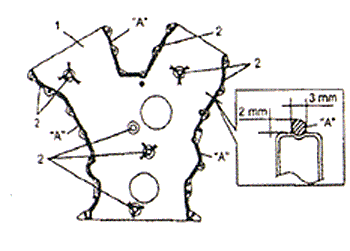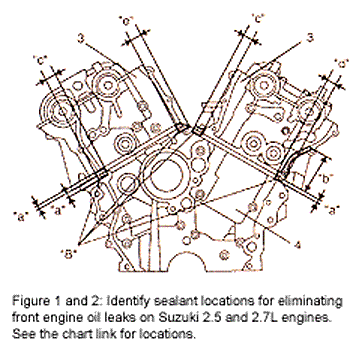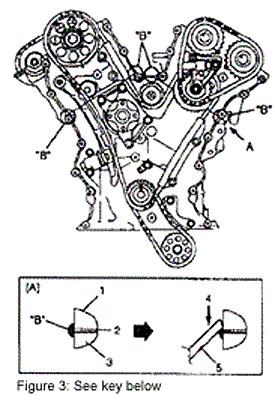Engine Builders: The AERA Technical Committee offers the following information regarding a front engine oil leak on 1999-2003 Suzuki 2.5 & 2.7L engines. If oil is observed leaking from the left front of the engine resealing the timing cover may resolve those types of customer complaints.
To do so, two types of sealers are recommended from Suzuki to use at specific locations of the front cover. Refer to the illustrations below and follow the steps indicating the locations to use sealers “A” (Figure 1) or “B” (Figure 2).

Clean sealing surface on timing chain cover, crankcase, cylinder block and cylinder heads. Remove oil, old sealant, and dust from sealing surface.
Apply sealant “A:” Suzuki Bond 1207F (p/n 99000-31250) to timing chain cover sealing surface area as shown in the Figure 1. Ensure proper sealant bead. Do not over apply.
Apply sealant “B:” Suzuki Bond 1207B (p/n 99104-31140) to the mating surfaces of the cylinder heads and cylinder block as shown in Figure 2.

Use a plastic scraper as a jig to force the sealer into the air gap formed by the cylinder head, block and head gasket as shown in Figure 3, call-out “A.” There are four areas “B” where this must be performed.
NOTE: Failure to perform the fourth step will result in oil weepage/seepage that will migrate down the front side of the engine block. This may appear and be misdiagnosed as a crankshaft oil seal leak.
| Figure 1 (Sealant A)
1.Timing chain cover 2. Sealant “A” Figure 2 (Sealant B) 1. Timing chain cover 2. Sealant depth a-e 3. Cylinder head 4. Cylinder block “a”: 7 mm (0.28 in.) “b”: 67 mm (2.64 in.) “c”: 17 mm (0.67 in.) “d”: 18 mm (0.71 in.) “e”: 10 mm (0.39 in.) Figure 3 (B and A) 1. Cylinder head 2. Cylinder head gasket 3. Cylinder Block 4. Rub into 5. Plastic scraper or equivalent. [A] View A |
Key to sealant locations for Suzuki 2.5L/2/7L engines.













